Attached files
| file | filename |
|---|---|
| EX-99.1 - PRESS RELEASE DATED NOVEMBER 3, 2016 - AutoWeb, Inc. | ex99-1.htm |
| 8-K - FROM 8-K - AutoWeb, Inc. | abtl8k_nov32016.htm |
EXHIBIT
99.2
AUTOBYTEL
INC.
Moderator:
Sean Mansouri
November
3, 2016
5:00
p.m. ET
Operator:
This
is Conference # 93691416.
Operator:
Good
afternoon, everyone. Thank you for participating in today's
conference call to discuss Autobytel's financial results for the
third quarter ended September 30, 2016.
Joining
us today are Autobytel's President and CEO, Jeff Coats, the
Company's CFO, Kimberly Boren, and the Company's outside Investor
Relations Advisor, Sean Mansouri, with Liolios Group.
Following
their remarks, we'll open the call for your questions.
I
would now like to turn the call over to Mr. Mansouri for some
introductory comments.
Sean Mansouri:
Thank
you, Amber. Before I introduce Jeff, I remind you that during
today's call, including the question-and-answer session, any
projections and forward-looking statements made regarding future
events or Autobytel's future financial performance are covered by
the Safe Harbor statements contained in today's press release, the
slides accompanying this presentation, and the Company's public
filings with the SEC. Actual events may differ materially from
those forward-looking statements.
Specifically,
please refer to the Company's Form 10-Q for the quarter ended
September 30, 2016, which was filed prior to this call, as well as
other filings made by Autobytel with the SEC from time to time.
These filings identify factors that could cause results to differ
materially from those forward-looking statements.
There
are slides included with today's presentation to help illustrate
some of the points being made and discussed during the call. The
slides can be accessed by visiting Autobytel's website at
www.autobytel.com. When there, go to “Investor
Relations” and then click on “Events and
Presentations.”
Please
also note that during this call and/or in the accompanying slides,
management will be disclosing non-GAAP income and non-GAAP EPS,
which are non-GAAP financial measures as defined by SEC Regulation
G. Reconciliations of these non-GAAP financial measures to the most
directly comparable GAAP measures are included in today's press
release and/or in the slides, which are posted on the Company's
website.
And
with that, I'll now turn the call over to Jeff.
Jeff Coats:
Thank
you, Sean. Good afternoon, everyone. Thank you for joining us today
to discuss our third-quarter 2016 results. As a reminder to those
of you new to Autobytel, we are a pioneer and the leading provider
of online digital automotive services connecting end market buyers
with our dealer and OEM customers to help them sell more cars and
trucks.
Our
third quarter was highlighted by the strong momentum of our
advertising related click product, which has continued to exceed
our expectation since acquiring AutoWeb in October 2015. For our
new audience, the click product is one that facilitates a visitor
clicking on a web advertisement and being taken to that
advertiser's website. As simple as it may sound,
AutoWeb's click platform allows Autobytel to provide dealers and
OEMs with access to some of the highest intent car shoppers on the
internet.
-1-
At
the end of the quarter, we launched the beta version of our new
lead enhanced product solution on AutoWeb.com. Initial customer
feedback is positive so we will continue to develop similar new
products that will ultimately help our dealer and OEM customers
sell more cars and make the path to purchase easier and more
enjoyable for consumers.
We
also launched a new beta version of our UsedCars.com site. This
revamped website is now fully responsive and mobile friendly. We
are extremely excited about the strength of the UsedCars.com domain
and will continue to invest in it in an effort to make it the
premier used vehicle destination for consumers.
But
before commenting further, I'd like to turn the call over to Kim
and have her take us through the important details of our financial
results. Kim?
Kimberly Boren:
Thanks,
Jeff, and good afternoon, everyone. For those of you following
along with our earnings presentation, on slide 4 you can see our
third-quarter revenues increased 9 percent to a Q3 record $43.9
million compared to $40.2 million in the year-ago quarter. The
increase in revenue was driven by growth in continued investment in
our AutoWeb offer as well as the continued expansion of most OEM
programs.
Lead
revenue from automotive dealers (our retail channel) was $13.8
million compared to $15.3 million last year, while lead revenue
from automotive manufacturers and wholesale customers (our
wholesale channel) increased 6 percent to $21.1 million. The
expected decline in retail revenues was driven by the transition of
190 retail dealers into one comprehensive OEM program in the second
quarter of 2016. This transition has proven to be a success as
overall revenues for the program have increased 25
percent.
Additionally,
over the last 12 months, we have systematically reduced lower
quality lead supply which in the short term has impacted both
retail and wholesale revenue. However, longer term, it's providing
positive results. In fact, early indicators such as three and
six-month retail dealer retentions are both up nicely in the most
recent periods. The overall increase in our wholesale channel was
driven by continued strong demand from OEM customers.
Moving
on to advertising, our advertising revenues increased 130 percent
to $7.4 million, compared to $3.2 million in the year-ago quarter.
The increase was both due to growth in display and other
advertising, as well as a significant increase in click
revenues.
On
slide 5 you'll see click revenues in the third quarter increased
282 percent, to $5.5 million, compared to $1.4 million in the same
period last year. The triple-digit year-over-year increase in click
revenue was driven by continued strong growth in AutoWeb. The
momentum in our click product is further evidenced by the 50
percent sequential increase from Q2.
Moving
now to slide 6, you'll see that we delivered approximately 2.6
million automotive leads during the third quarter, compared to 2.8
million last year. Sequentially, lead volume increased 22 percent
as a result of increased lead supply associated with high quality
lead gen methodologies that have begun to replace the low-quality
volume we removed over the last 12 months, together with normal
seasonality and strong OEM demand.
Consistent
with lead revenue, retail new leads were down 9 percent compared to
the prior-year quarter while used leads were flat. 76 percent of
leads were delivered to the wholesale channel, with the remaining
24 percent to the retail channel. Retail new leads invoiced per
dealer remained constant year over year in the third quarter of
2016, and retail used leads invoiced per dealer was up 11
percent.
-2-
We
delivered more than 95,000 specialty finance leads during the
quarter, down 8 percent from the year-ago period. Despite the
decline in leads, specialty finance lead revenue was relatively
flat at $1.7 million compared to last year, reflecting our
successful implementation of price increases.
On
slide 7, you'll see we adjusted the dealer count to historically
exclude the aforementioned retail dealers that were transitioned
into a comprehensive OEM program in Q2 2016. As of September 30,
dealer count stood at 4,271, an 8 percent decline over prior year.
The decrease was driven by the expected dealer churn from the
Dealix acquisition as we continue to focus on building stronger
relationships with larger, more profitable dealers. I remind
listeners that this figure does not include the dealers on our OEM
network, which would otherwise be closer to 22,000 dealer
franchises.
Now
moving to slide 8, gross profit during the third quarter increased
3 percent to $15.8 million, and gross margin was 35.9 percent
compared to 38.1 percent in the year-ago quarter. In the third
quarter we made the decision to begin further investing in our
traffic acquisition in order to accelerate the growth of our lead
and click products. The decline in gross margin was due to the
corresponding increase in traffic acquisition costs as we focus
more on accelerated growth and incremental gross profit dollars as
opposed to gross margin percentage.
Gross
margin was also impacted by an increase in amortization of
intangible assets associated with the acquisition of AutoWeb. We
expect gross margin to continue in the mid 30 percent range over
the next several quarters as we invest in our core products to grow
revenues and ultimately profit dollars.
Total
operating expenses in the third quarter were $11.5 million compared
to $12 million in the year-ago quarter. As a percentage of
revenues, total operating expenses were 26.2 percent compared to
29.8 percent in the third quarter of 2015, with the decrease
largely attributable to non-recurring transaction related expenses
in 2015, as well as cost savings from our IT development migration
which was initiated in the first quarter of 2016.
While
we’ve recognized significant cost savings over the course of
the year, we plan to reinvest more going forward and further
accelerate the growth opportunities we see in our
business.
On
a GAAP basis, net income in the third quarter increased 70 percent
to $2.7 million or $0.21 per diluted share on 13.3 million shares.
We expect our diluted share count in the fourth quarter to be
around 13.5 million, and full year 2016 to be 13.4 million,
contingent upon our share price and assuming current outstanding
shares, warrants, options, and convertible debt remain
constant.
For
the third quarter, non-GAAP income, which adds back amortization on
acquired intangibles, non-cash stock-based compensation,
acquisition costs, severance costs, gain on investment, litigation
settlements, and income taxes, increased 26 percent to $6.5 million
or $0.49 per diluted share compared to $5.2 million or $0.45 in the
year-ago quarter. Cash provided by operations for the 2016 third
quarter improved to $5.9 million compared to $5.1 million in the
prior-year quarter.
On
slide 9, you'll see that our cash balance remains strong, with cash
and cash equivalents of $32.7 million at September 30, 2016, which
represents a 36 percent increase from December 31, 2015. Total debt
at September 30, 2016, was reduced to $23.1 million compared to $27
million at the end of 2015.
With
that, I'll now turn the call back over to Jeff.
-3-
Jeff Coats:
Thank
you, Kim. As I mentioned earlier, our third quarter was highlighted
by the continued momentum of our click product and strong demand
from most of our OEM customers. In addition, we successfully
completed the beta launch of our new UsedCars.com site and lead
enhanced product solution on AutoWeb.com.
I'll
spend some time covering each of these topics, beginning with
clicks. For those of you new to Autobytel, our click product came
to us through our acquisition of AutoWeb, which is a pay-per-click
programmatic advertising marketplace targeting the auto industry.
This acquisition continues to exceed our expectations as the
AutoWeb platform provides dealers and OEMs with access to some of
the highest-intent car shoppers on the Internet.
As
Kim noted earlier, the growth in AutoWeb's click revenue continues
to accelerate, up 50 percent sequentially to $5.5 million. We are
increasing volumes with existing clients and continue to add OEMs,
large dealer groups, dealer agencies, and Tier II dealer
associations. Additionally, the churn on this product continues to
exceed expectations, well below the industry norms we are
accustomed to.
When
describing advertising spend in the automotive industry, activities
are typically segmented into three tiers. Tier I is OEM national
brand spend. Tier II is regional spend. And Tier III is advertising
at the dealership level. It's important to note that for many OEMs,
the Tier II regional associations have advertising budgets that are
collectively larger than the OEMS national Tier I
budgets.
And
now with AutoWeb, in addition to Tiers I and Tier III, we have an
attractive Tier II product offering for the first time in our
history. These sophisticated clients recognize the flexibility of
our AutoWeb technology and are eager to use it to get incremental
high-intent traffic and to enhance the user experience and the
efficiency of their entire ecosystem of consumer facing
websites.
At
the end of the third quarter, we rolled out the beta version of our
new lead enhanced product solution on AutoWeb.com, where, upon the
completion of a lead form, we are opening a map and/or tabs for
dealers and advertisers to drive consumers to their respective
websites. Though we will continue to test and refine the offer, we
believe this handoff to a dealer or OEM's website will add value to
our core leads product and increase closing rates for our dealer
customers.
As
mentioned earlier in the year, we've migrated our previously
outsourced development resources to our in-house Guatemala
operations. During the quarter we continued to invest in both our
US and Guatemala development resources to further accelerate the
growth of both our click and core leads products and especially our
new UsedCars.com website. We currently plan to continue the
investment in our products and in our development teams throughout
2017.
Moving
on now to our strong lead volumes, in the third quarter, we began
investing heavily in traffic acquisition to accelerate the
replacement of the low-quality lead supply we had removed over the
last 12 months with our own higher quality internally generated
lead supply.
Through
this investment, we were able to sequentially increase lead supply
by 22 percent, more than double the historical seasonal range of 10
percent.
And
as we have mentioned in previous quarters, OEMs tend to be very
selective in their digital marketing spend, and they continue to
demonstrate increasing demand for our high-quality leads. We
believe this is a direct result of our commitment to quality, which
was further reflected by our decision to walk away from low quality
lead-gen methodologies that did not meet our high-quality
requirements.
We
expect to continue investing in our core leads products to continue
to capitalize on the record level demand from our OEM and dealer
customers. This investment will also support additional growth in
our clicks products. Further, I remind listeners that when your
account for leads that we deliver to OEMs, we are actually
delivering leads to approximately 22,000 dealer franchises which
includes our retail dealer network.
The
breadth of our influence on the auto industry is further
illustrated on slide 10, where you can see that sales from
consumers submitting leads through Autobytel's network accounted
for approximately 5 percent of all new light vehicle retail sales
in the United States in 2015 and approximately 2 percent of all
used car sales. We expect volume to have grown in 2016 and look
forward to receiving the final updated IHS data when it's released
early next year.
On
slide 11, you'll see that our estimated average buy rate for
internally generated leads in the third quarter was 17 percent.
This figure includes the buy rate from Dealix leads, so we were
pleased with our performance in raising the legacy Dealix lead
quality up to the low end of our targeted range of 16 percent to 24
percent. Because of our ongoing commitment to lead quality, we are
continuing to focus on enhanced methodologies to meaningfully
increase the mix of internally generated leads from the current 80
percent level, while only utilizing volume from a small number of
trusted suppliers who share our commitment to quality.
And
on slide 12, as derived from IHS Automotive Reports, you will note
that these estimated buy rates have remained consistently strong
since Q1 2011, with Autobytel.com generating an average buy rate of
24 percent and all Autobytel internally generated leads at about 18
percent.
Used
car lead revenue in the third quarter was up 5 percent sequentially
to $3.8 million, driven by the strong recovery in quality lead
supply from Dealix in late June. Our used car business remains a
focal point for growth, and we continue to increase the level of
resources dedicated to ramping our used car platforms for internal
lead generation as well as incremental sales and
marketing.
As
noted earlier, we successfully launched the beta version of our new
UsedCars.com site at the end of the third quarter. This new
platform is being powered by our Car.com code base, AutoWeb's data,
and our inventory services, all of which enable a very scalable
operation. We continue to expect realizing more of the benefits of
this new site in 2017.
As
a reminder, retail used car leads still only represent about 7
percent of our total leads business today and approximately 9
percent of revenue, even though used car sales in the United States
are two to three times that of new car sales by volume. We
originally expected to see more growth in the used car product in
2016. However, a disproportional amount of the lower quality lead
volumes we eliminated were used cars. With the launch of the new
UsedCars.com, we expect to return to the originally anticipated
growth levels.
It's
also worth noting that we have seen many dealers begin to increase
the level of investment in their used car businesses. In fact, the
CEO of Auto Nation recently announced a major initiative to focus
on used vehicles and launch used only retail locations. While
several other large dealer groups, including Sonic Automotive, have
also initiated similar strategies. This reinforces our decision to
meaningfully invest in and grow our used car business, which we
continue to view as a major opportunity.
-4-
Moving
on to the industry outlook, as you can see on slide 13, Automotive
News has the seasonally adjusted annual run rate, or SAAR, for
total sales at 18 million units for October 2016, slightly down
from 18.1 million units one year ago and up 2 percent compared to
September 2016. And on slide 14 you'll see that in October, LMC
Automotive and J.D. Power maintained their full year total light
vehicle sales forecast at 17.4 million, a 0.2 percent decline from
2015. The forecast for retail light vehicle sales also remains at
14 million units, down 1.5 percent from 2015.
For
listeners who follow the industry at large, you have likely seen
the headlines highlighting October as the sixth monthly decline of
new vehicle retail sales in 2016. Despite these industry dynamics,
we've actually begun to experience increasing demand from our
customers as they are now even more eager to get consumers into
their showrooms to maintain their own top line growth.
Now
moving on to our 2016 business outlook, highlighted on slide 15, we
now expect 2016 revenue to range between $153 million and $155
million, an increase at the bottom end of our original guidance of
$151 million to $155 million which represents an increase of
approximately 15 percent to 16 percent from 2015. We expect
non-GAAP income to range between $16.5 million and $16.9 million,
representing an increase of approximately 7 percent to 10 percent
with non-GAAP diluted EPS ranging between $1.23 and $1.26 compared
to $1.22 in 2015, down from the original guidance of $1.39 to
$1.43.
I
want to take a moment to reinforce why we made the decision to
moderate our 2016 non-GAAP EPS guidance. Q3 was a precursor for why
we have made this decision to start investing now. Q3 allowed us to
see what was possible from a revenue perspective while allowing
some flexibility in margin.
The
performance in Q3 provided a level of verification that we have the
assets, core products, and talent to drive strong growth. It also
gave us insight into where we needed further investment to fuel our
growth. We are excited about the opportunities on our roadmap and
we feel capitalizing on these opportunities now is the best thing
to do for our business. We believe that adding talent, enhancing
our products, growing traffic, and creating value across the
company's assets will allow us to monetize these
opportunities.
As
we close out another strong year and look ahead to 2017, we'll
continue to focus on providing our dealer and OEM customers with
high quality, high-intent car buyers. Be it through new or used
care leads, clicks, or one of our many value-added product
offerings, we remain committed to helping our customers sell more
cars and trucks.
Operator
will now take questions.
Operator:
Thank
you, sir. Ladies and gentlemen if you have a question at this time,
please press star one on your telephone keypad. If your question
has been answered or you wish to remove yourself from the queue,
please press the pound key. And one moment while callers queue for
their question. And that’s star one for
question.
Your
first question comes from the line of Eric Martinuzzi with Lake
Street Capital.
Eric Martinuzzi:
Thanks.
Congratulations on a strong Q3. I have a question about the Q4
guidance though. I wanted to take a look at it just because this is
I think the first true organic quarter that we get with the
anniversary of the AutoWeb acquisition. If I look at the midpoint
of the guidance, we're at about a 4 percent growth rate. Now I know
there's some cross currents here because you did talk about really
cleansing, the cleansing of the Dealix automotive leads. But when
we kind of anniversary that, and I don't know whether that's Q2 or
Q3, is this a mid-single digit growth story?
-5-
Or,
given the investments that you're making now is this a high single
digit story, potentially double digits? Just some insight there
would be helpful.
Jeff Coats:
Eric,
I would say the investments that we're making will increase the
growth in our top line, accelerate the growth in our top line. We
would normally be, I think, a high single digit grower. These new
investments will, over the course of next year, accelerate that. So
it's possible we would hit something in the higher levels, but what
we would currently plan to do would be on our Q4 call, which will
be in February next year, lay out a more detailed level of guidance
for 2015 as well as some -- I'm sorry, for 2017. As well as provide
some more insight for what the business should look like in the
future.
Eric Martinuzzi:
Okay.
And what is the anniversary of that, the kind of Dealix cleansing?
Was it Q2 you said or was it Q3 for this year?
Kimberly Boren:
So
we took most of it out in Q1. So from a clean quarter perspective,
Eric, that would be Q2 2017.
Eric Martinuzzi:
Okay.
And then you are definitely the engine behind the pay per click
revenue. We're seeing that in the cost of goods kind of the tac
being higher. Is that -- are you finding -- obviously they're
profitable clicks that you're buying and turning into pay per click
leads for your pay per click advertising for your own customers.
Are you finding those available at a constant price or is the tac
rising maybe at a higher cost per click for you? Or is it strictly
a volume issue?
Jeff Coats:
Honestly,
it's probably all over the board. There is no such thing as a
constant price in the way we do business or when you do business
with Google the way we do. It's individual auctions based on
different strings of key words. So it's constantly in flux. You
know, as we've discussed, overall pricing in a lot of these areas
have increased over time.
We've
been very successful with the additional investments we've been
making in our business historically to stay ahead of that by
producing better technology that ultimately yields us stronger
conversion rates. So we are actually yielding more product out of
what we're buying than we used to. So it's a daily struggle in our
business.
Eric Martinuzzi:
Okay.
And then lastly, back to the pay per click business, just
phenomenal growth there, seeing that up 50 percent sequentially.
Could you revisit again, who is the big consumer there? Who is the
customer?
Is
that -- you mentioned the Tier I, Tier II, Tier III, but is this an
OEM buy, is it an agency buy? Who are you selling that
to?
Jeff Coats:
I
would say the largest group currently is at Tier I, it's at the
manufacturer level. We also have some customers in the Tier II
level and then we also have quite a few dealer customers some of
whom we sold it to directly, but many of whom we sold it to through
their agency, their advertising agency. So it's a little bit a
mixed bag there across that.
I
would say the growth prospects are very strong, however, across all
three tiers. And I don't know if we've ever said this out loud like
this before, but we barely scratched the surface on the clicks
business. We have a very, very small number of customers on the
click business right now as compared to the leads business. So just
continuing to roll it out to some of our existing customers over
time gives us a very significant growth opportunity with even
existing customers.
Eric Martinuzzi:
Okay,
thanks for taking my questions.
Operator:
Your
next question comes from the line of Gary Prestopino with
Barrington Research.
-6-
Gary Prestopino:
Good
afternoon. Hi. I'm a little bit fuzzy on what exactly is going on
here, Jeff. And maybe it's my understanding of the business as well
as some of the internet guys, but you say you're increasing your
investment in new products or existing products, and I thought we
kind of went through that investment ramp the first half of this
year.
And
then also you're saying the gross margin is down and should
continue to be down because of your acquisition costs, I guess
whatever you're acquiring to drive AutoWeb growth. But my
understanding of it from you was that the AutoWeb business carries
a very high margin and should maybe mitigate some of what you're
spending here and wouldn't erode the gross margin as much. So can
you help me out on those two things.
Jeff Coats:
Sure.
I think perhaps the misunderstanding is, the kind of business that
we have is a business, being in digital and particularly now in the
clicks business, where we have to constantly reinvest in the
business to stay on the cutting edge of what's going on. So we've
just started to scale up the clicks products. And every time we add
customers, it's a new implementation, there's new development costs
associated with it. As we add new traffic sources, there are new
development costs and implementation costs associated with doing
that. So it's kind of an ongoing -- we never finish the development
work around some of those products.
When
we began with AutoWeb, yes, it was extremely high margin because
initially it was a rev share and everything that we brought into
our P&L before we bought the rest of AutoWeb, was basically at
a very high, almost 100 percent margin because of the rev
share.
Once
we bought them and started accounting for all of the costs, it
looked initially, and was for a period of time, the gross margin
was more in the 50 percent to 55 percent range. As we have
continued to understand the product, expand the product, add new
customers to the product and invest in the product, we have seen
opportunities for continued growth as part of doing
that.
In
the third quarter, throughout the quarter, we were doing a lot of
development experimentation trying to determine the best ways to
generate traffic directly for the clicks product. Not just the
traffic flow coming from the leads products, but new traffic
designed specifically for that. I think I also mentioned to you
that we weren't really sure where the gross margin would end up on
the clicks product because we were looking for ways to accelerate
our growth. And as part of doing that, we might have to moderate
that margin as part of doing it.
We
did make some of those determinations throughout the course of the
third quarter. As we had the results to review moving into the
fourth quarter, we made the decision, as opposed to turning down
certain revenue streams, to maintain a higher margin but slow down
our revenue growth, that we would in fact allow that revenue growth
to continue at the margins that were currently then being
generated.
So
we are continuing to experiment with the growth in the business.
There is a very significant growth opportunity here. And that's
where, that's what we're in the process of trying to lay out and
determine.
Gary Prestopino:
Thanks.
Jeff Coats:
It's
a work in progress.
Operator:
Again,
ladies and gentlemen, if you have a question at this time, simply
press star one on your telephone keypad.
Your
next question comes from the line of John Blackledge with
Cowen.
-7-
John Blackledge:
Great,
thanks. I hopped on a little late, so I apologize if these
questions were asked.
But
if we look out a couple of years, which tiers, OEM, dealer, etc.,
has the highest spend potential for the clicks business? How many
dealers have ramped on the program, the clicks program at this
point? Remind us about the retention.
And
then what do you think the ultimate gross margin for the clicks
business is? And then I have just one follow-up.
Jeff Coats:
Let
me do sort of the last one first. We're not yet sure what the
ultimate gross margin for the clicks business will be. As I was
discussing a moment ago, we're still kind of in the experimentation
phase there. In terms of the other stuff, there are huge budgets at
I'd say the Tier II and Tier I levels. I would expect that most of
our dollar revenue ultimately would probably be at Tier II and Tier
I. I think there is also a significant opportunity at the Tier III
level with dealers, but there are 30,000 franchises across the
United States. You only get to them one by one or through their
agencies, so it will take us longer to get to those in a meaningful
way, but there's still a very large opportunity there.
I
would say in the short term, it's probably Tier I, Tier II and then
Tier III. But ultimately Tier II could prove to be a larger market
for us because those budgets do tend to be larger than the national
advertising budgets for some of the OEMs.
There
are only a couple hundred dealers on the click product currently,
or less than a couple hundred dealers on the click product
currently. Very small slice. Big opportunity to grow for growth
there. And I know there was another one and I'm not remembering
it.
John Blackledge:
The
retention, Jeff, of the dealers.
Jeff Coats:
Oh,
yes. So, normally the churn in our industry is about 5 percent a
month for dealers. Dealers are always looking for new products to
spend their money on. In our core leads business we currently are
below 4 percent after the two acquisitions we did that caused our
own churn to jump up. The churn that we're currently seeing in the
clicks business is well less than 1 percent just to give you an
idea. It's been shockingly low.
But
in the context of what we're hearing from our customers, is the
quality of the traffic that they're buying from us is significantly
higher than the traffic that they're able to find from any of the
other providers out there currently. Which is not a big surprise
because it's the traffic coming off of our lead gen operations
which again is that 14 years of long tail search focused on
identifying signals of intent to buy. So, we're really only trying
to attract end market buyers that are looking to buy a car soon
that we then sell the information to our dealer and manufacturer
customers.
So
I would say the churn profile in clicks is actually one of the most
exciting parts of it so far because we run very hard in the leads
business and you see the dealer churn numbers that we post every
quarter. It's two steps forward some quarters and two steps back.
We don't expect to see that in the clicks side of the business.
We're very excited about it.
John Blackledge:
Yeah.
That's great. Just a follow-up. In terms of the dollars, where are
the dollars coming from---from the OEMs and the dealers? Is it
traditional channels or digital or a mix?
Jeff Coats:
It's
coming from their advertising budgets. I would assume some of it's
coming as they move more offline advertising over, but I'm sure a
portion of it is just being swung over from some of their digital
budgets now. And I’m sure it's also somewhat different
manufacturer to manufacturer.
John Blackledge:
Right.
Thank you very much.
-8-
Operator:
At
this time, this concludes our question and answer session. I would
now like to turn the call back over to Mr. Coats for closing
remarks.
Jeff Coats:
Thank
you. Thanks to everybody for joining us on the call today. And I
also want to thank our team of dedicated employees. I'll be at the
RBC Conference in New York next week, so I look forward to talking
to some of our investors there. Thank you.
Operator:
Ladies
and gentlemen, this does conclude today's teleconference. You may
disconnect your lines at this time. Thank you for your
participation.
END
-9-
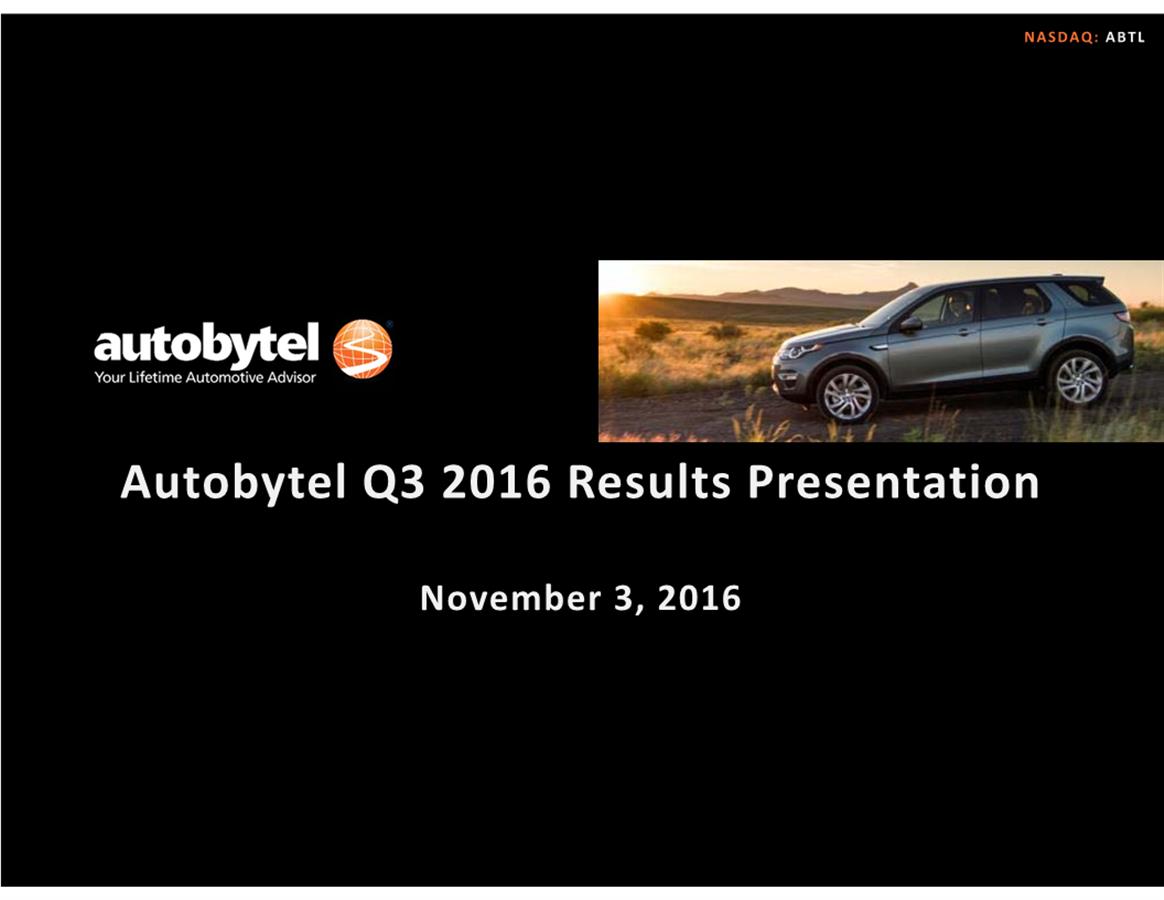
-10-
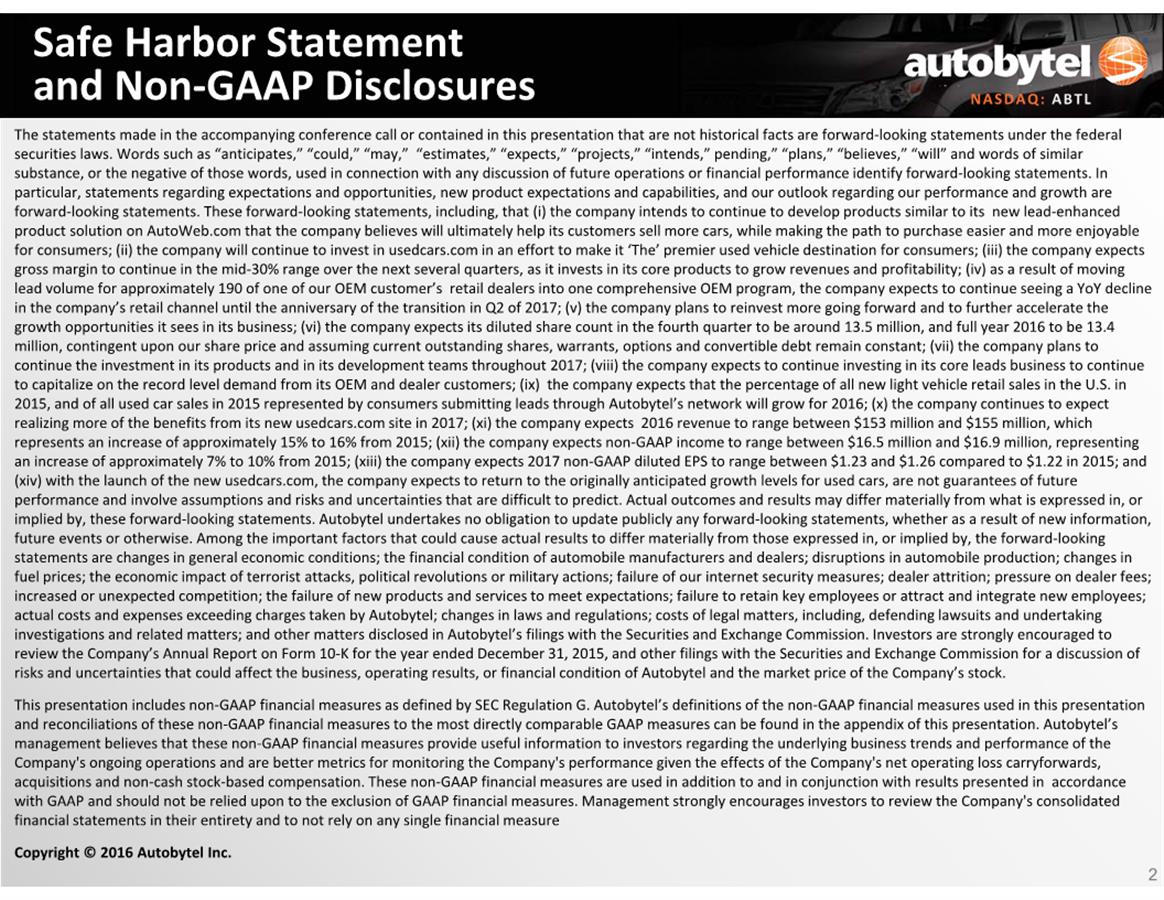
-11-
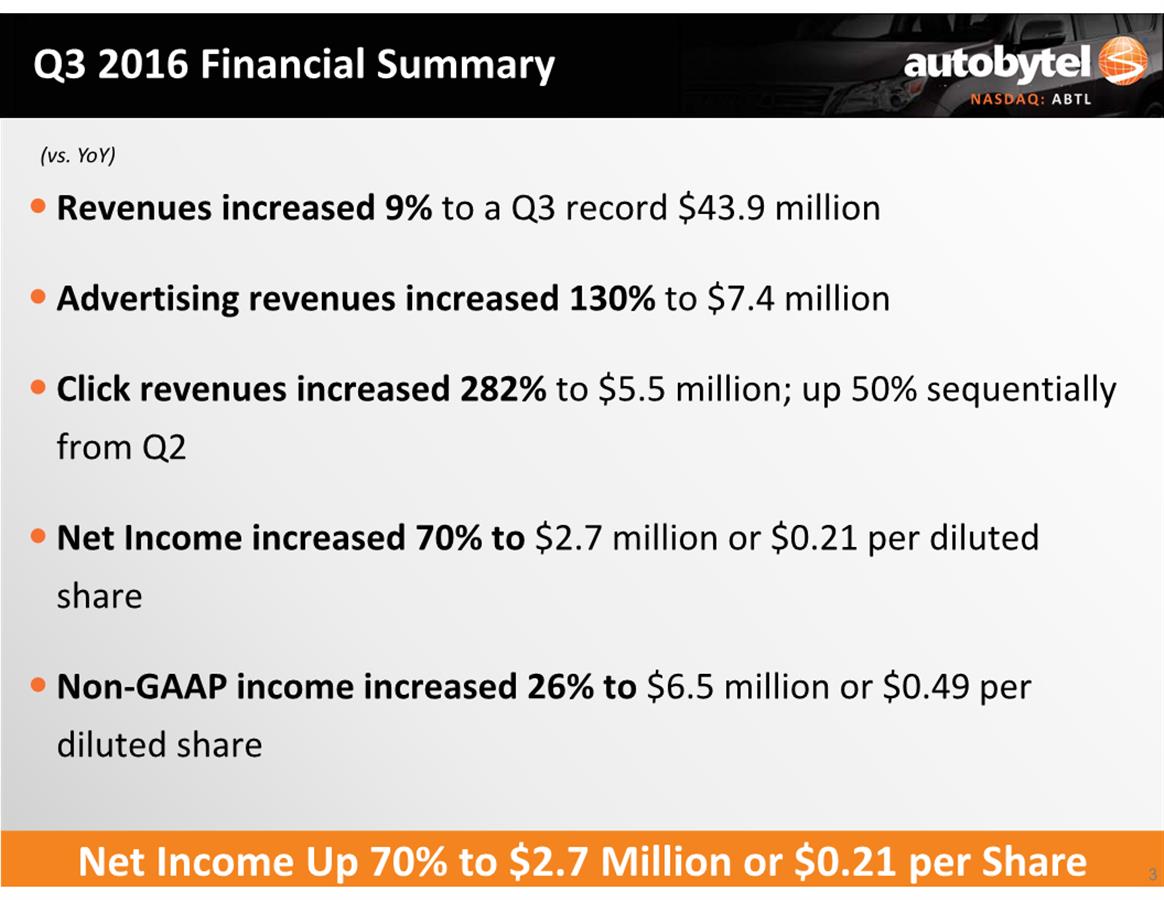
-12-
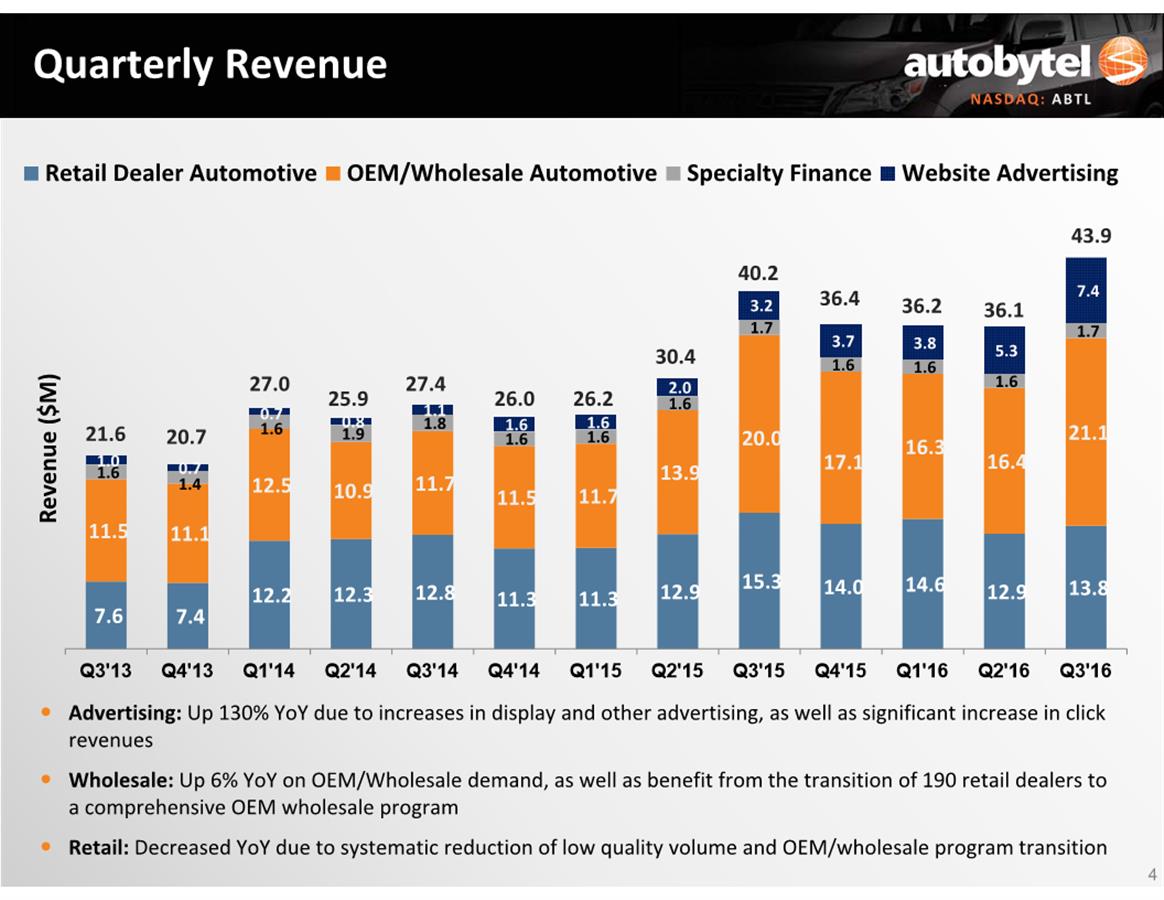
-13-
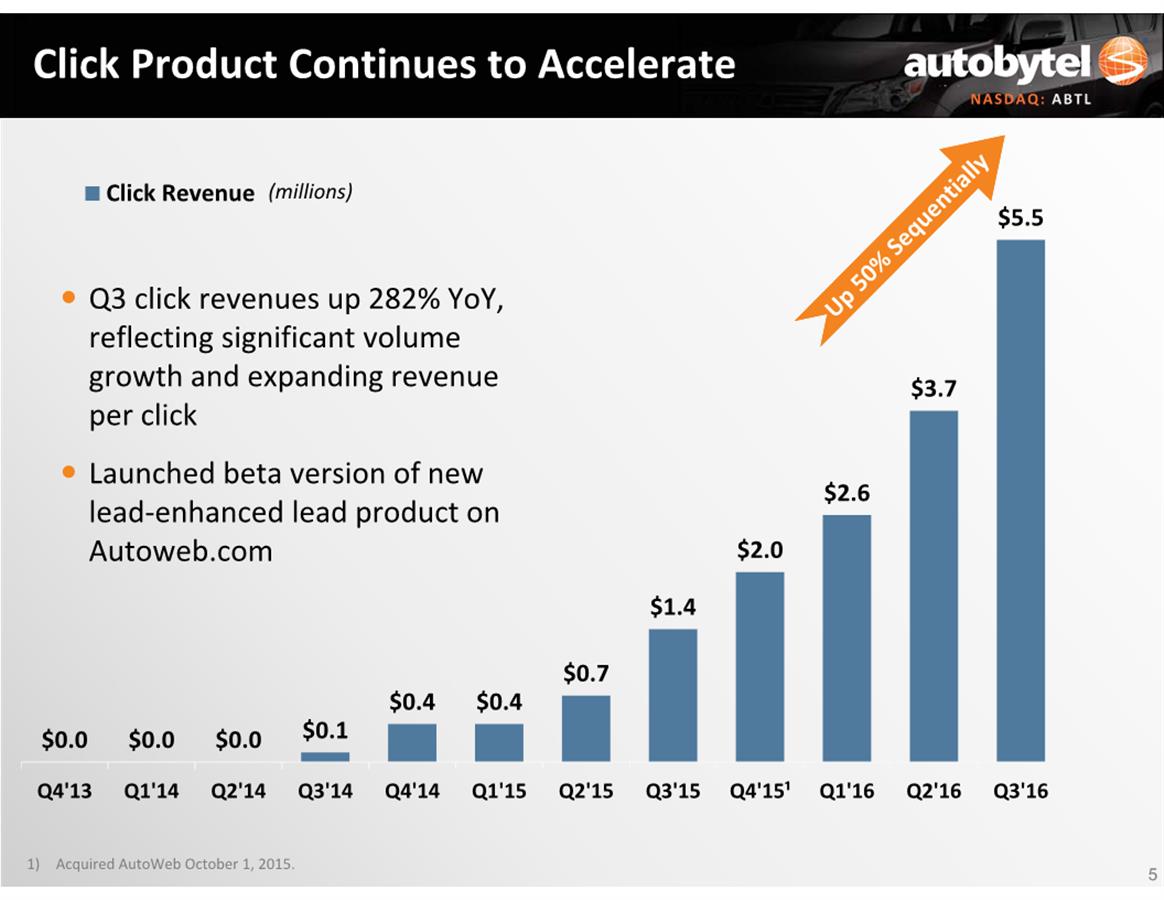
-14-

-15-
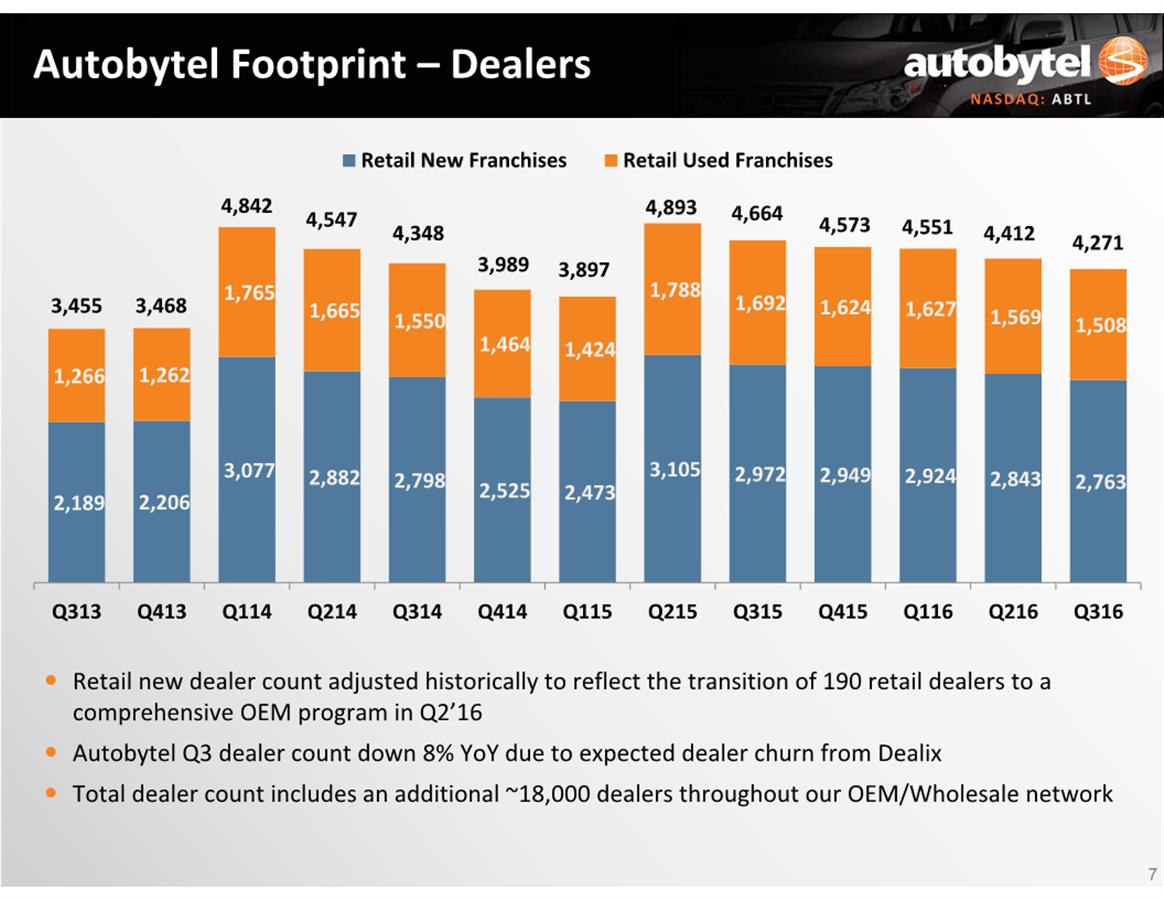
-16-
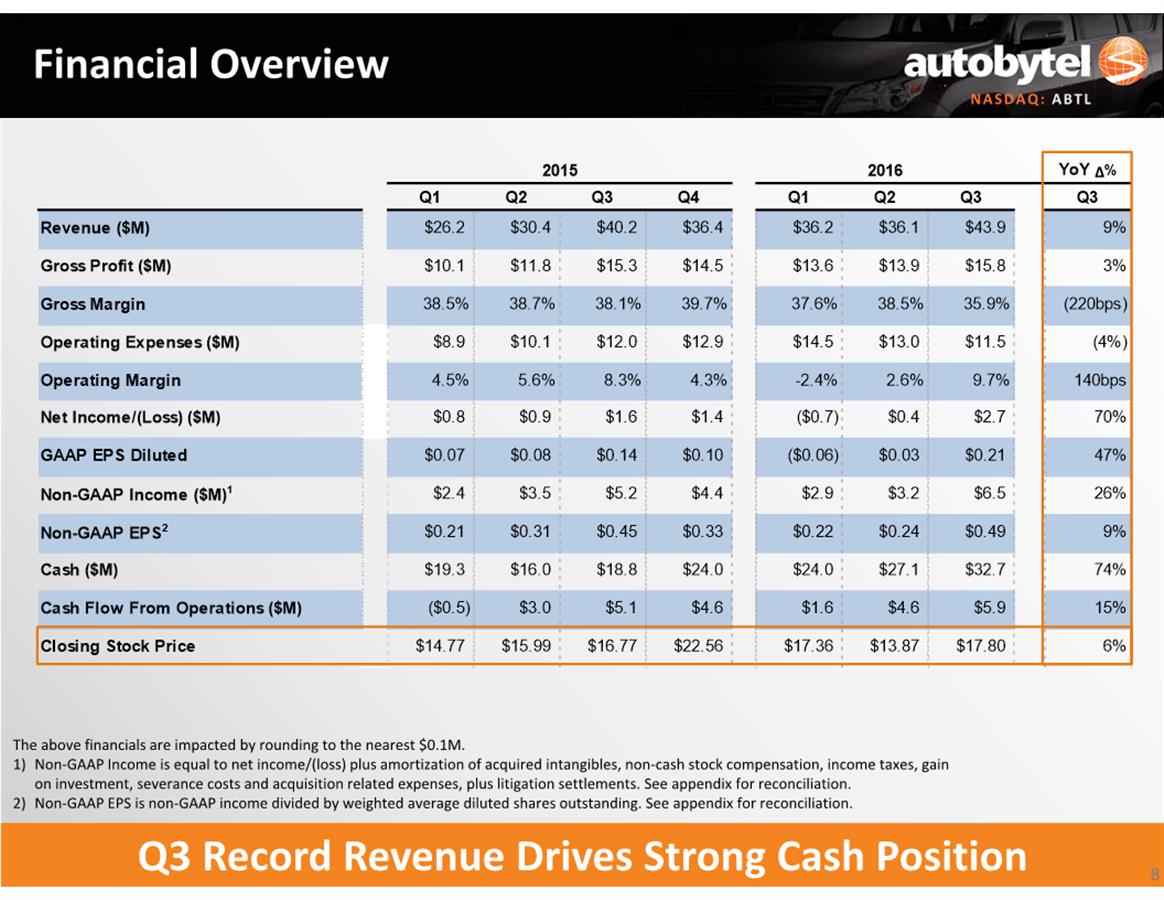
-17-
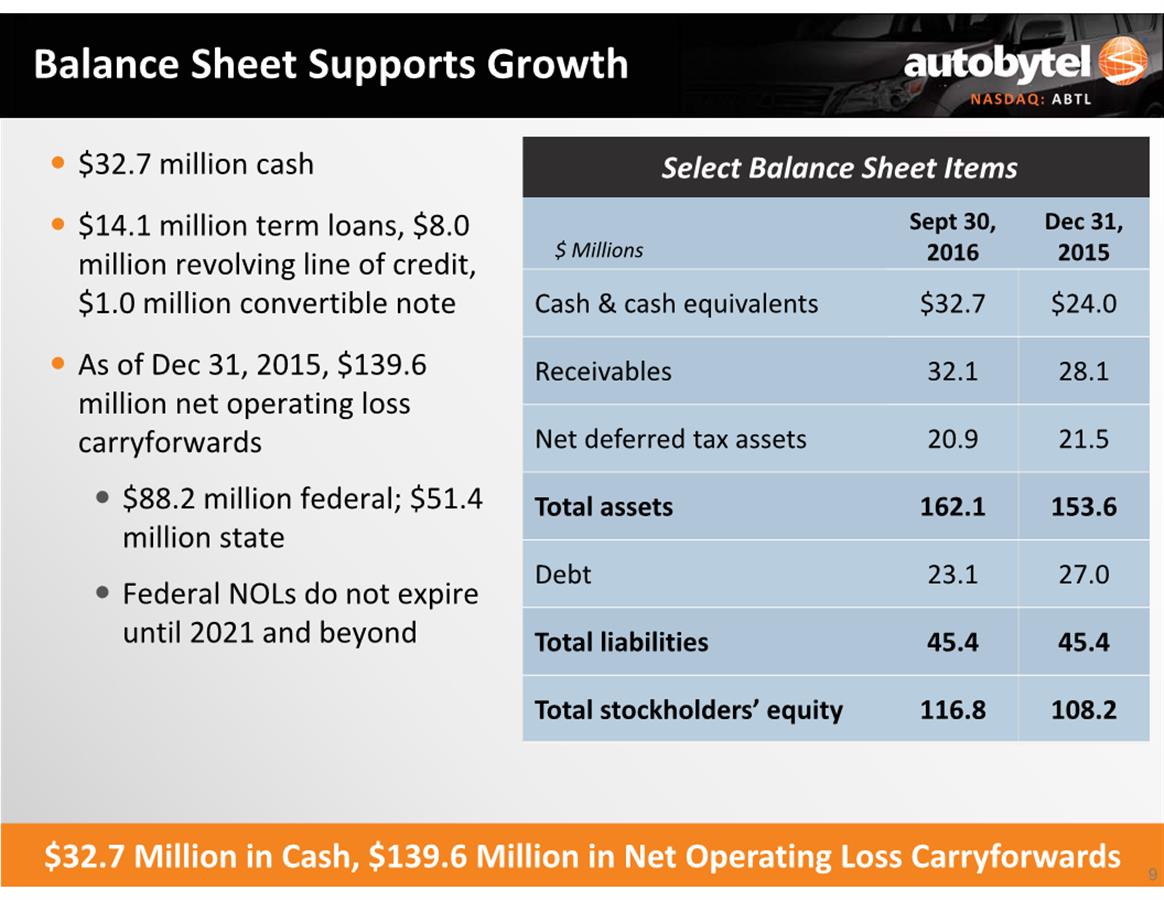
-18-
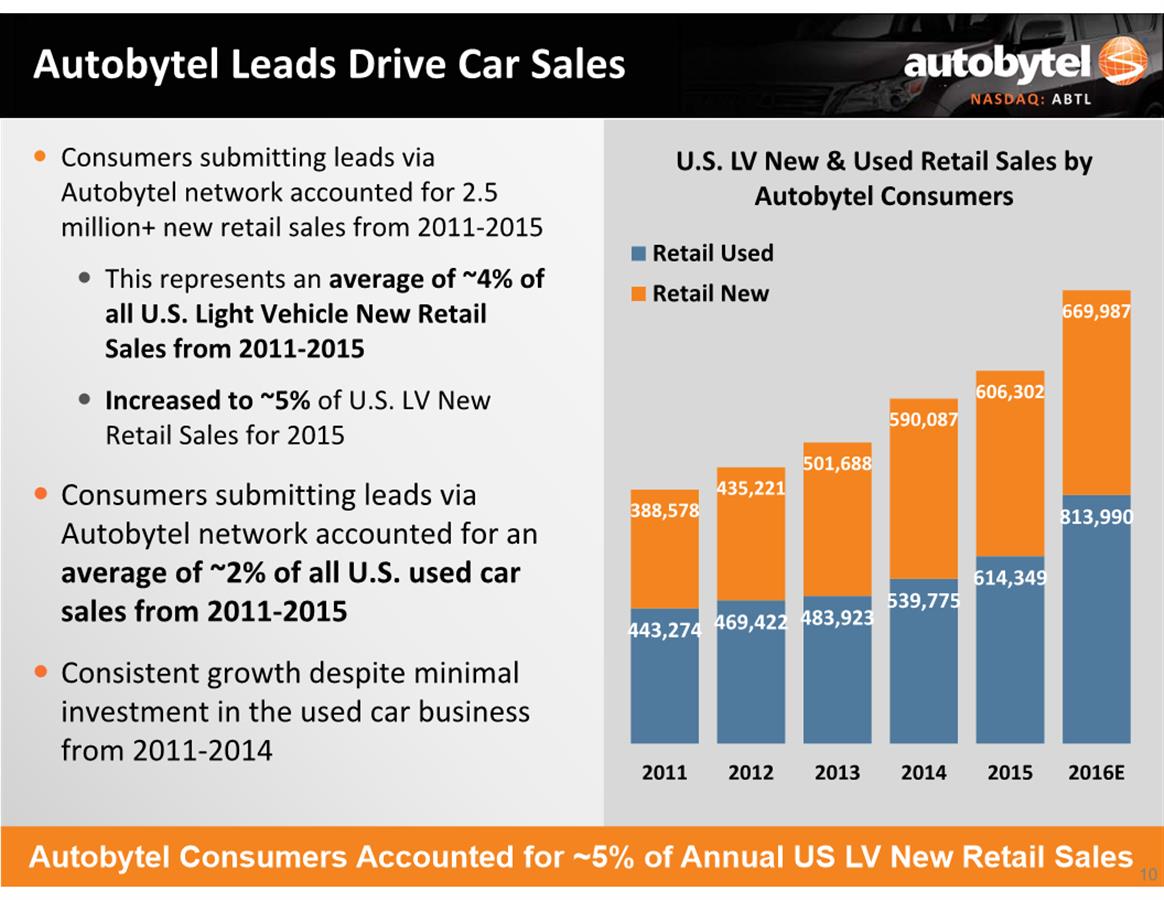
-19-

-20-
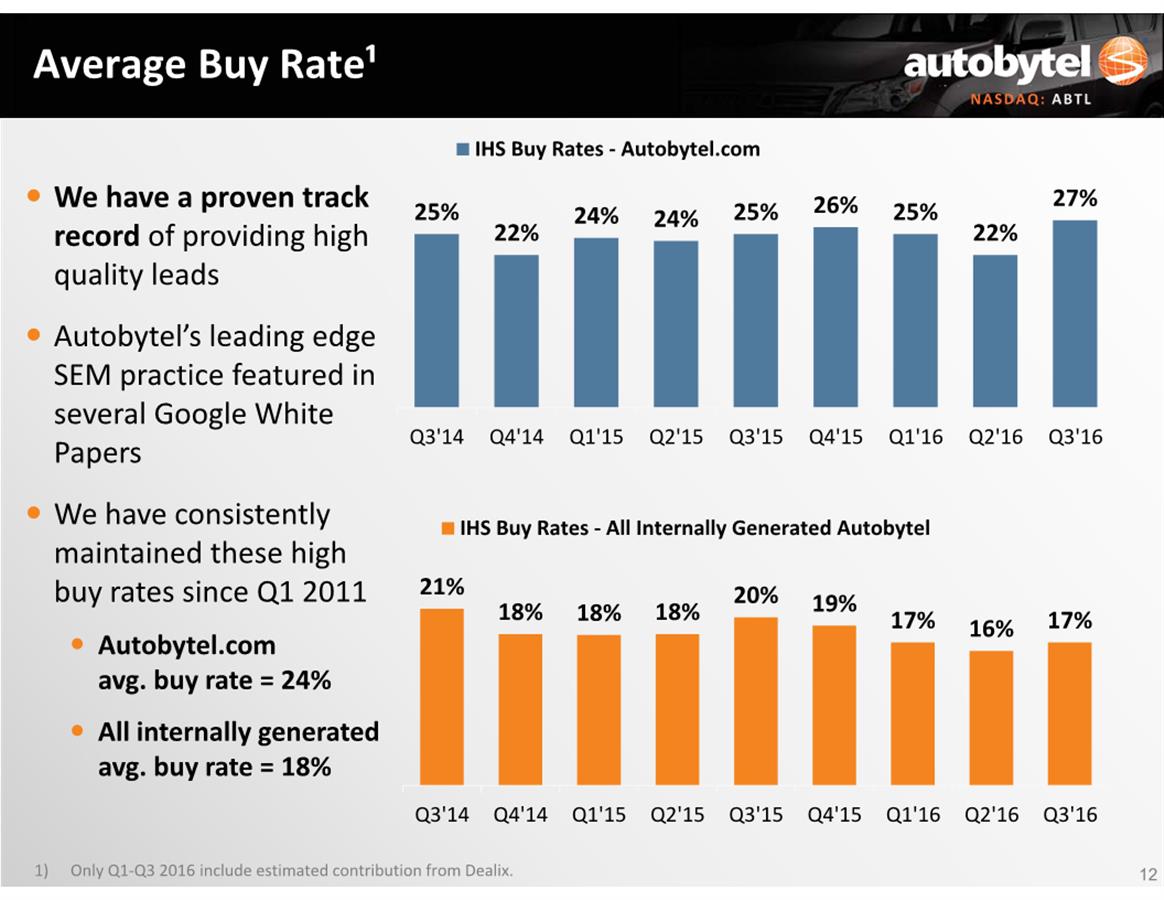
-21-
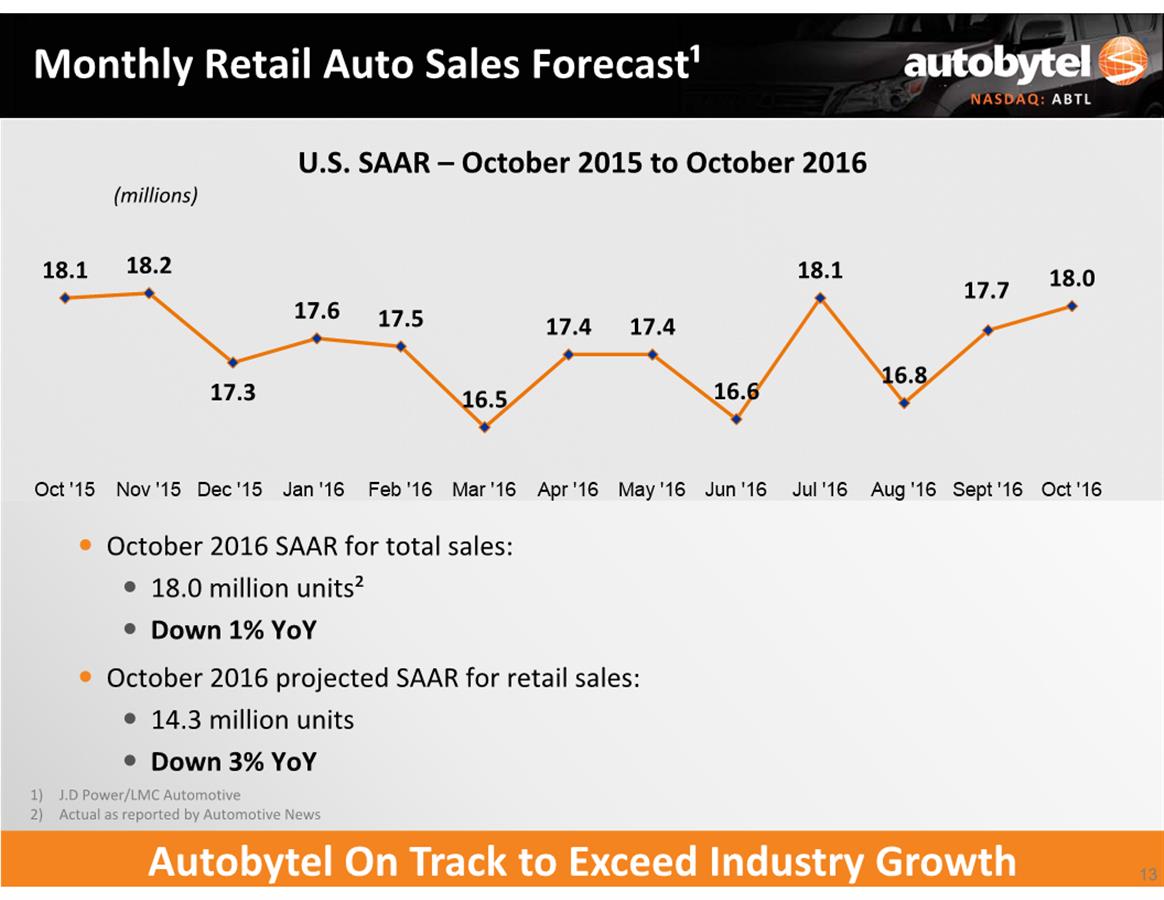
-22-
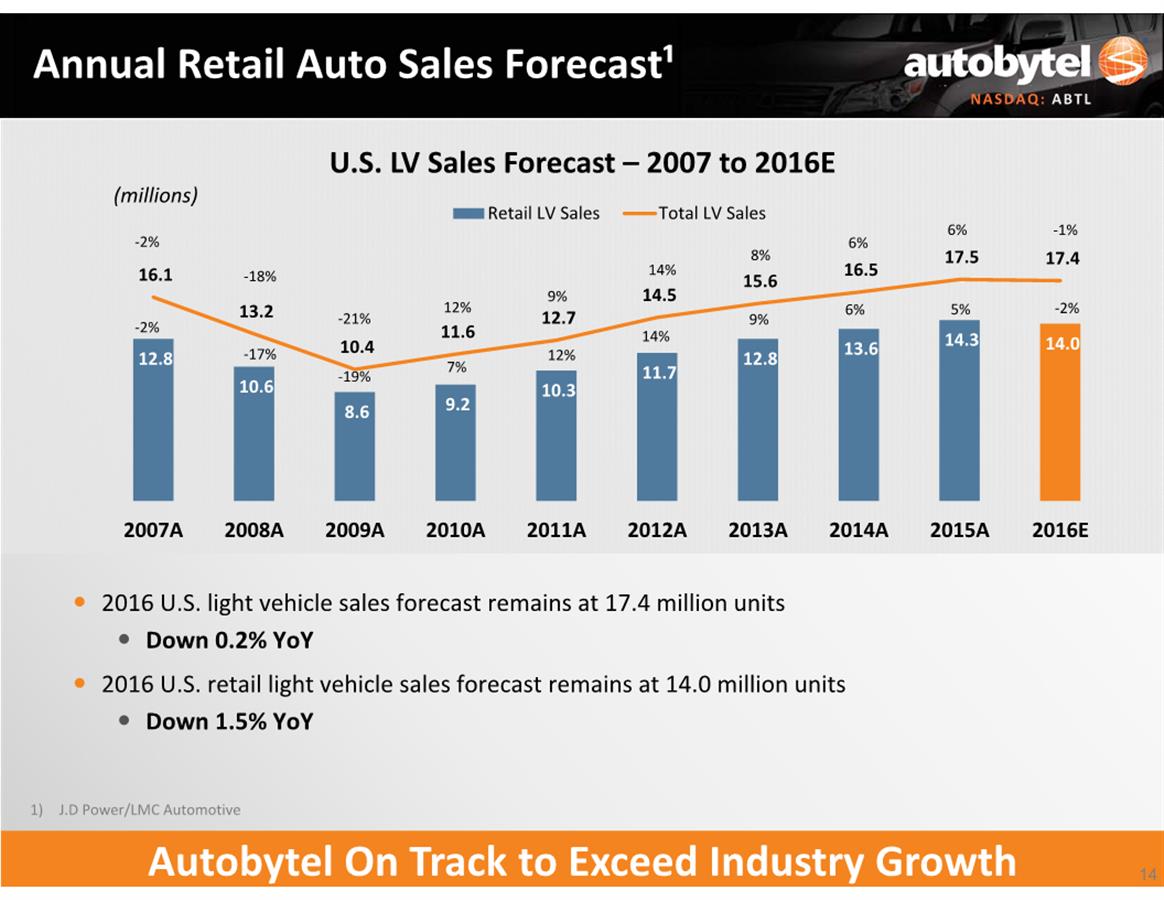
-23-
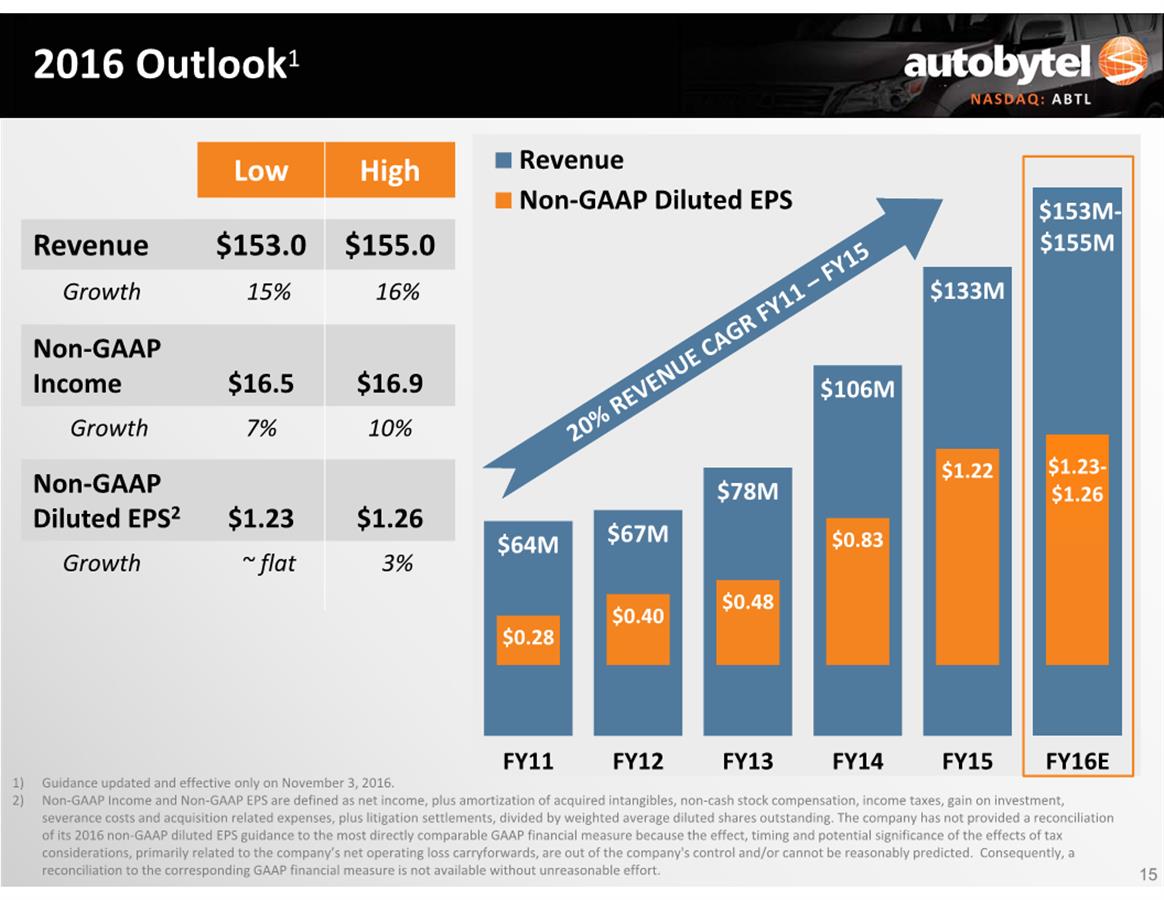
-24-
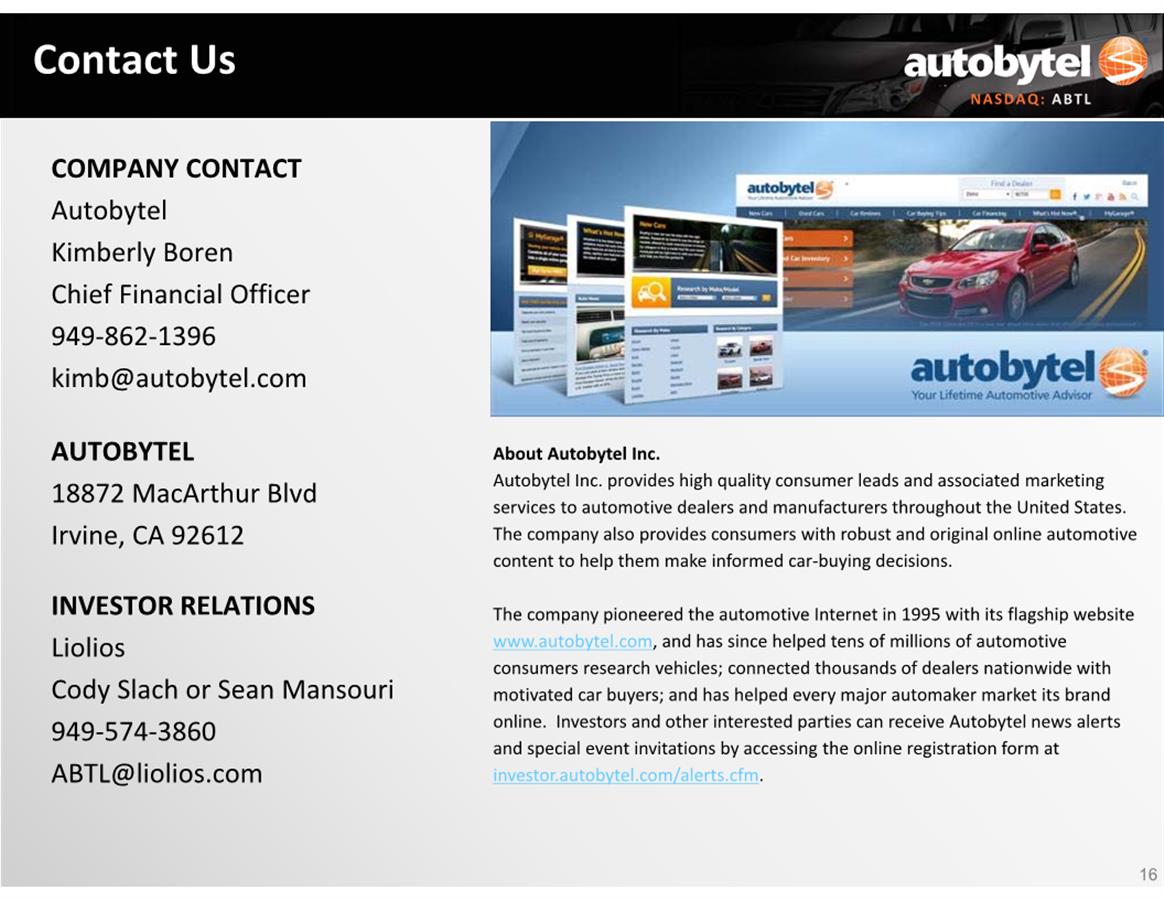
-25-
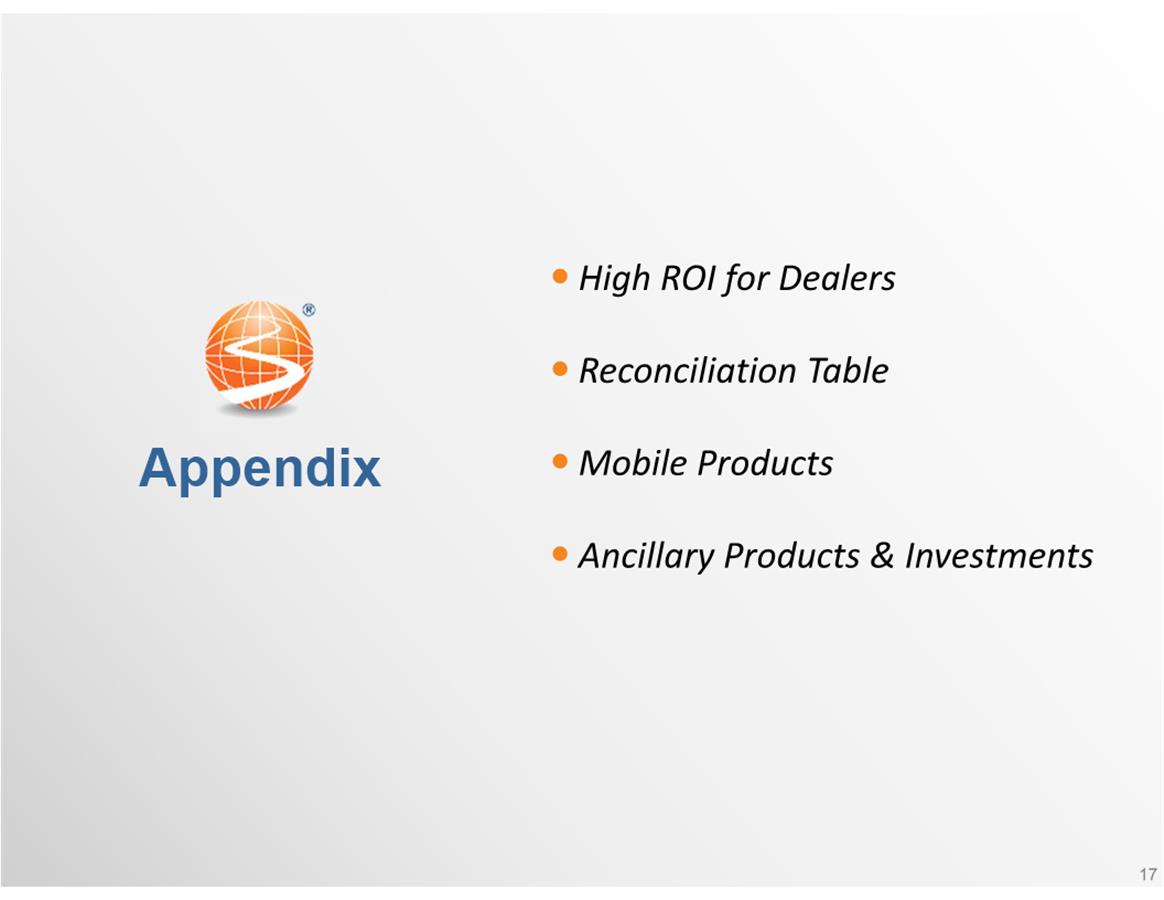
-26-
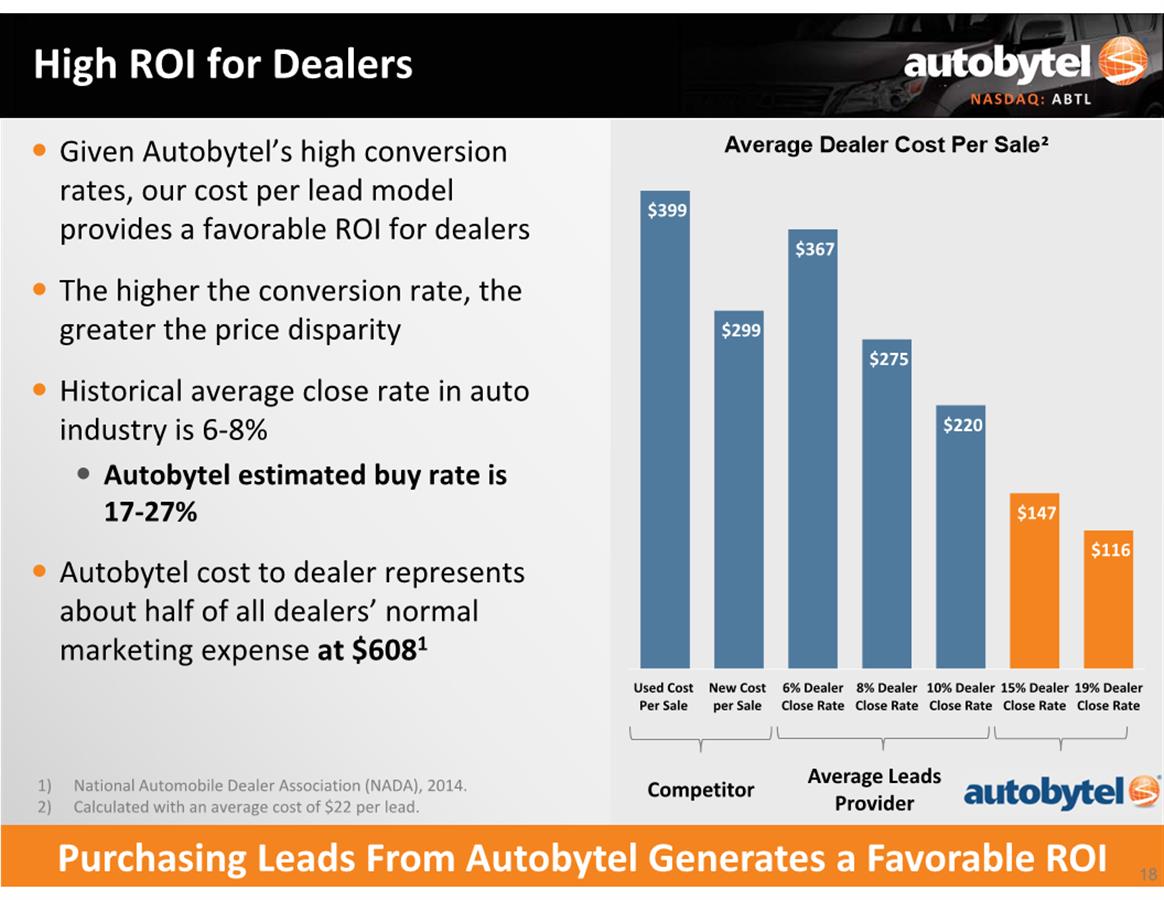
-27-
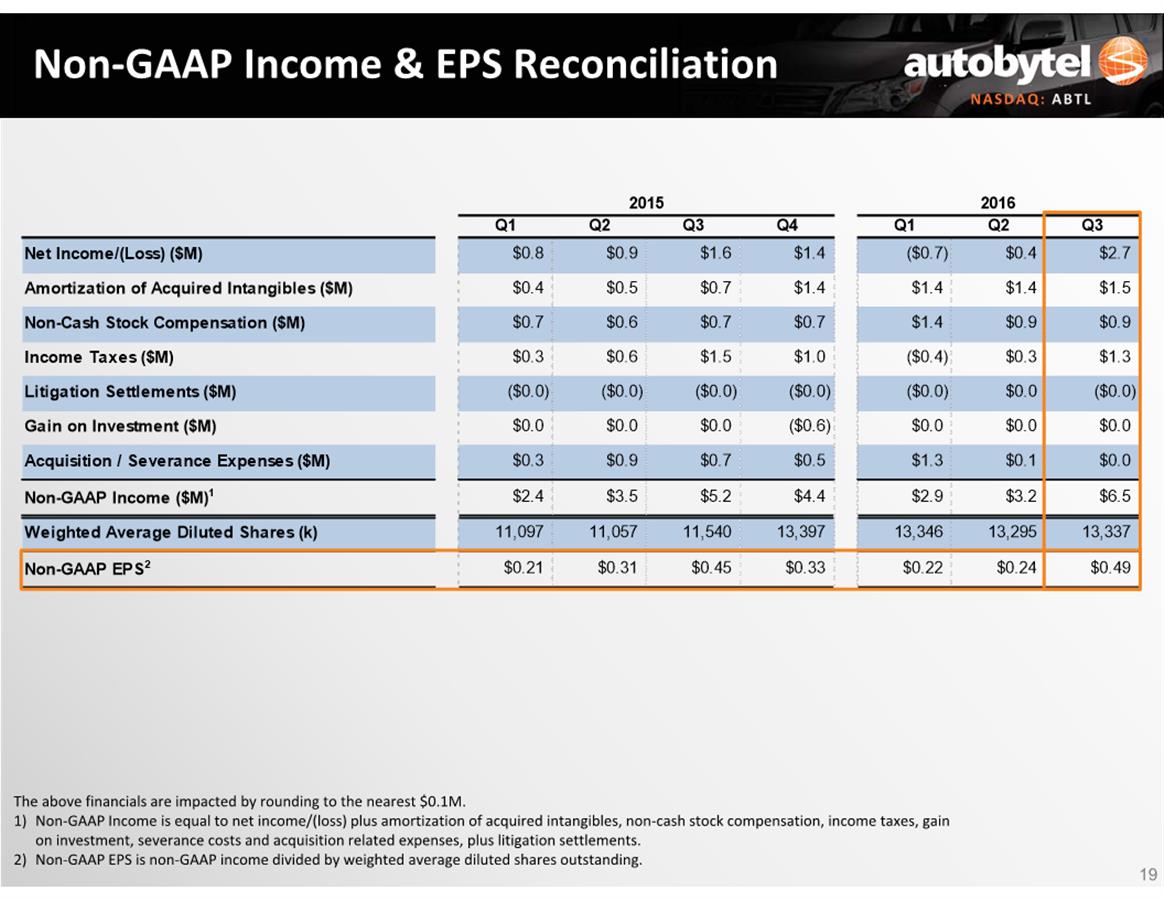
-28-
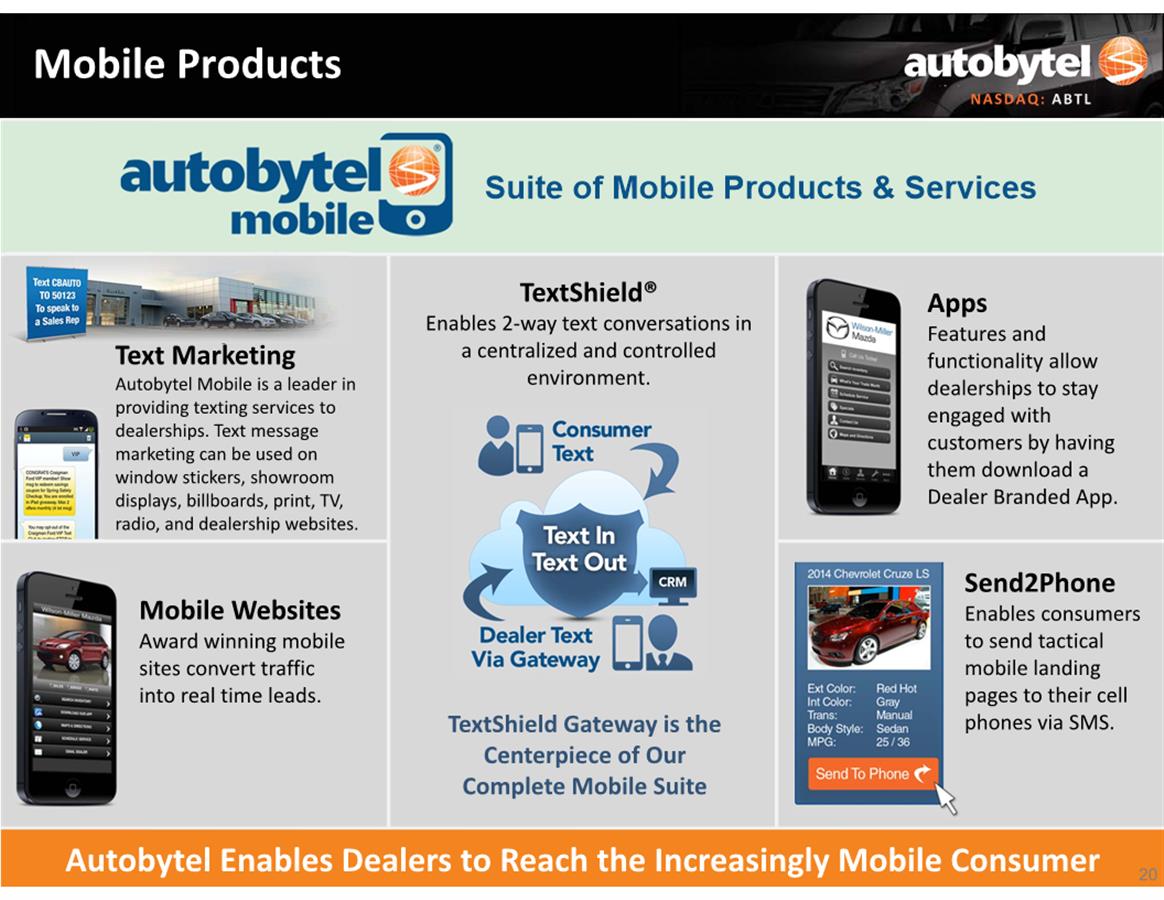
-29-

-30-
